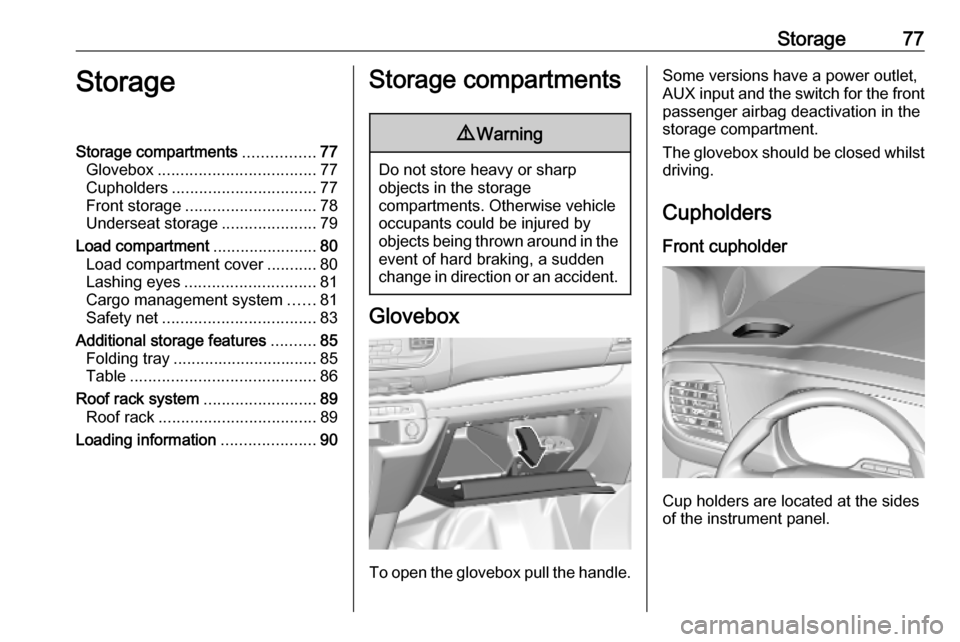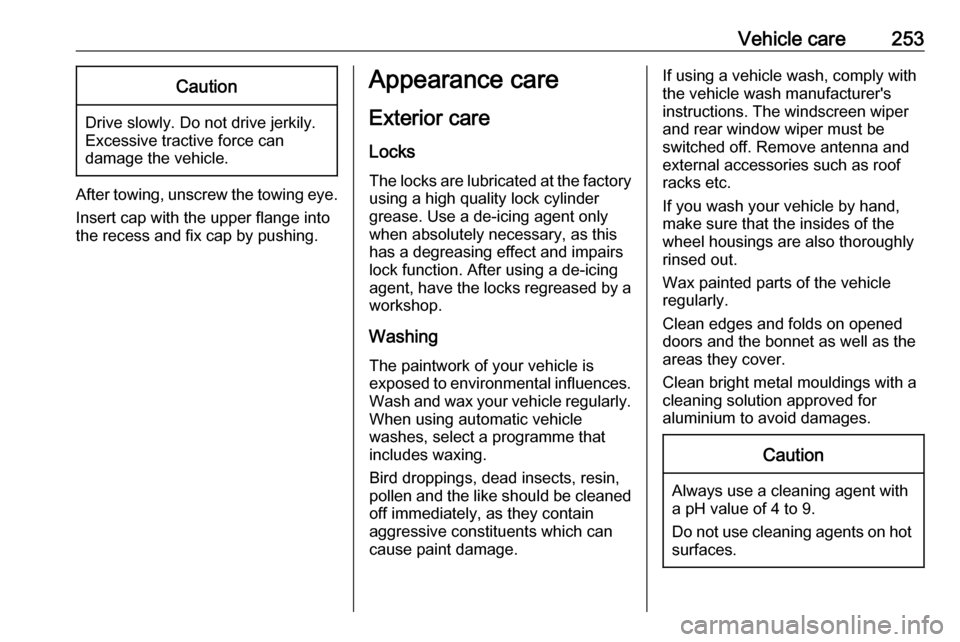roof rack VAUXHALL VIVARO C 2020 Owner's Manual
[x] Cancel search | Manufacturer: VAUXHALL, Model Year: 2020, Model line: VIVARO C, Model: VAUXHALL VIVARO C 2020Pages: 289, PDF Size: 10.16 MB
Page 79 of 289

Storage77StorageStorage compartments................77
Glovebox ................................... 77
Cupholders ................................ 77
Front storage ............................. 78
Underseat storage .....................79
Load compartment .......................80
Load compartment cover ...........80
Lashing eyes ............................. 81
Cargo management system ......81
Safety net .................................. 83
Additional storage features ..........85
Folding tray ................................ 85
Table ......................................... 86
Roof rack system .........................89
Roof rack ................................... 89
Loading information .....................90Storage compartments9Warning
Do not store heavy or sharp
objects in the storage
compartments. Otherwise vehicle
occupants could be injured by
objects being thrown around in the
event of hard braking, a sudden
change in direction or an accident.
Glovebox
To open the glovebox pull the handle.
Some versions have a power outlet,
AUX input and the switch for the front passenger airbag deactivation in the
storage compartment.
The glovebox should be closed whilst
driving.
Cupholders
Front cupholder
Cup holders are located at the sides
of the instrument panel.
Page 91 of 289

Storage89The handle in the front has to be in the
tightened position. Place the rear of
the multifunctional table on the rail
and tip the front down. Slide the
multifunctional table until it engages.9 Warning
Never use the multifunctional table
in the unfolded position while thevehicle is in motion. Any objects
on the table will turn into
projectiles in the event of a sudden stop or collision.
Ensure that the multifunctional
table is correctly folded before
moving or removing it.
Never use the tables as seats or
lean on them.
Check that there is no object
obstructing the rail and preventing locking.
Roof rack system
Roof rackFor safety reasons and to avoid
damage to the roof, the vehicle
approved roof rack system is
recommended. For further
information contact your workshop.
Follow the installation instructions
and remove the roof rack when not in
use.
The roof load is the combined weight
of the roof rack and the load.
Loading information 3 90.
Mounting
Fasten the roof rack according to the
installation instructions delivered with the roof rack.
The number and location of the
mounting points may vary depending
on the vehicle:Vehicles with glass panel
Mount two roof bars using the
mounting points marked in the
picture.
Permissible roof load L1, L2, L3 max.
100 kg.
Page 92 of 289

90StorageVehicles without glass panel
Mount three roof bars using the
mounting points marked in the
picture.
Permissible roof load L1, L2, L3 max.
150 kg.
Mount the roof rack using the
mounting points marked in the
picture.
Permissible roof load L1 max.
140 kg.
Permissible roof load L2, L3 max.
170 kg.
Vehicle dimensions 3 270
Loading information
● Heavy objects in the load
compartment should be placed
against the seat backrests. Make
sure that the backrests are
securely engaged. If objects can
be stacked, heavier objects
should be placed at the bottom.
● Prevent sliding of loose objects by securing them with straps
attached to the lashing eyes.
Lashing eyes 3 81.
● Do not allow the load to protrude above the upper edge of the
backrests.
Page 192 of 289

190Driving and operatingspeed range and only responds to
detected vehicles and
pedestrians.
System limitations
In some cases, the active emergencybraking system may provide an
automatic braking in situations that
seem to be unnecessary, for instance
in parking garages, due to traffic signs
in a curve or due to vehicles in
another lane. This is normal
operation, the vehicle does not need
service. Firmly apply the accelerator
pedal to override the automatic
braking if the situation and the
surroundings permit.
In the following cases, active
emergency braking performance is
limited:
● Driving on winding or hilly roads.
● Detecting all vehicles, especially vehicles with a trailer, tractors,
muddy vehicles, etc.
● Detecting a vehicle when weather limits visibility, such as infog, rain, or snow.
● Driving during nighttime.
● The windscreen is damaged or affected by foreign items, e.g.
stickers.
Complete attention is always required
while driving, and the driver should be ready to take action and apply the
brakes and / or steer the vehicle to
avoid crashes.
We recommend to deactivate the
system in the vehicle personalisation
in the following cases:
● when towing a trailer or caravan
● when carrying long objects on roof bars or a roof rack
● when the vehicle is being towed with the engine running
● when tyre chains are fitted
● when a spare wheel is fitted that is smaller than the other wheels
● before using an automatic car wash with the engine running
● before placing the vehicle on a rolling road in a workshop
● if the windscreen has been damaged close to the camera● if the front bumper has beendamaged
● if the brake lamps are not working
Fault
In case the system requires a service, m is illuminated in the instrument
cluster, a message is displayed in the
Driver Information Centre and an
audible signal is given.
If the system does not work as it
should do, vehicle messages are
displayed in the Driver Information
Centre.
Vehicle messages 3 122.
Front pedestrian protection Front pedestrian protection may help
to avoid or reduce the harm caused
by front-end crashes with pedestrians when driving forward.
The system uses the front camera in
the windscreen and a radar sensor in
the front bumper to detect a
pedestrian directly ahead in your path.
Page 255 of 289

Vehicle care253Caution
Drive slowly. Do not drive jerkily.
Excessive tractive force can
damage the vehicle.
After towing, unscrew the towing eye.
Insert cap with the upper flange into
the recess and fix cap by pushing.
Appearance care
Exterior care LocksThe locks are lubricated at the factoryusing a high quality lock cylinder
grease. Use a de-icing agent only
when absolutely necessary, as this
has a degreasing effect and impairs
lock function. After using a de-icing
agent, have the locks regreased by a
workshop.
WashingThe paintwork of your vehicle is
exposed to environmental influences.
Wash and wax your vehicle regularly.
When using automatic vehicle
washes, select a programme that
includes waxing.
Bird droppings, dead insects, resin,
pollen and the like should be cleaned
off immediately, as they contain
aggressive constituents which can
cause paint damage.If using a vehicle wash, comply with
the vehicle wash manufacturer's instructions. The windscreen wiperand rear window wiper must be
switched off. Remove antenna and
external accessories such as roof
racks etc.
If you wash your vehicle by hand,
make sure that the insides of the
wheel housings are also thoroughly
rinsed out.
Wax painted parts of the vehicle regularly.
Clean edges and folds on opened
doors and the bonnet as well as the
areas they cover.
Clean bright metal mouldings with a
cleaning solution approved for
aluminium to avoid damages.Caution
Always use a cleaning agent with
a pH value of 4 to 9.
Do not use cleaning agents on hot surfaces.
Page 287 of 289

285Particulate filter........................... 160
Performing work ........................212
Peripheral lighting .......................137
Power button .............................. 153
Power outlets ............................... 97
Power seat adjustment ................49
Power sliding doors ......................30
Power windows ............................ 41
Preheating ................................. 112
Puncture ..................................... 245
R Radio Frequency Identification (RFID) ..................................... 280
Radio (Infotainment system)....... 123
Radio remote control ...................22
Rain sensor ................................ 114
REACH ....................................... 276
Reading lights ............................ 135
Rear doors .................................... 30
Rear fog light .............114, 133, 225
Rear seats ................................... 52
Rear view camera ...................... 199
Rear windows .............................. 42
Rear window wiper and washer ..96
Recommended fluids and lubricants ........................ 262, 266
Refuelling ................................... 204 Registered trademarks ...............276
Reversing lights .........................134Ride control systems ..................170
Roadside assistance ..................127
Roller blinds ................................. 44
Roof .............................................. 45
Roof bars ...................................... 89
Roof load ...................................... 90
Roof rack ..................................... 89
S Safety net .................................... 83
Seat adjustment ............................. 7
Seat belt ........................................ 8
Seat belt reminder .....................109
Seat belts ..................................... 56
Seat folding .................................. 50
Seat heating ................................. 51
Seat position ................................ 47
Selective catalytic reduction .......161
Selective ride control ..................171
Selector lever.............................. 165
Service ............................... 150, 259
Service display .......................... 108
Service information ....................259
Service vehicle soon .................. 111
Side airbag system ......................63
Side blind spot alert ............115, 194
Sidelights .................................... 129
Side turn lights ........................... 228
Sliding doors ................................ 30
Sliding side doors .........................30SOS............................................ 127
Spare wheel ............................... 245
Speed limiter....................... 115, 176
Speedometer ............................. 104
Starting and operating ................152
Starting off ................................... 18
Starting the engine ....................154
Steering ...................................... 152
Steering column controls ..............94
Steering wheel .............................. 94
Steering wheel adjustment ......9, 93
Steering wheel controls ...............93
Stop engine ................................ 111
Stop-start system........................ 156
Storage ......................................... 77
Storage compartments .................77
Sunvisor lights ........................... 136
Sun visors .................................... 44
Symbols ......................................... 4
System check ............................. 111
T
Table............................................. 86
Tachometer ............................... 106
Tailgate ......................................... 32
tailgate window ............................. 42
Tail lights ................................... 225
Three-point seat belt .................... 57
Tools .......................................... 234
torch............................................ 134